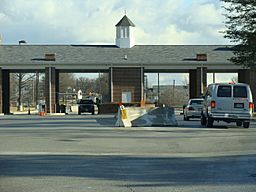Fort George G facts for kids
Quick facts for kids Fort George G |
|
| Military installation | |
|
Maryland Route 175 is beyond the main gate
|
|
| Eponym: George Meade, Army of the Potomac | |
| Country | |
|---|---|
| State | |
| County | |
| Part of | Intelligence and Security Command |
| Borders on | E: Severn, Maryland, W: National Cryptologic Museum, W: National Vigilance Park, W: Training School Cemetery |
| Parts | Fort Meade CDP |
| Location | wooded lot |
| - elevation | 173 ft (53 m) |
| - coordinates | 39°6′25″N 76°44′35″W / 39.10694°N 76.74306°W |
| Area | 7.92 sq mi (20.5 km²) |
| - CDP | 6.6 sq mi (17.1 km²) |
| Population | 48,008 CDP residents dependants: 6,000 42,133 employed (2010) military: ≈10,689 NSA: >20,000 DISA: 4000 |
| Access | Controlled |
| GNIS ID | 2512196 |
Fort George G. Meade is a big base for the United States Army in Maryland. It's home to many important groups. These include the Defense Information School, the United States Army Field Band, and the main offices for United States Cyber Command and the National Security Agency.
The fort is named after George Meade, a famous general from the American Civil War. He led the Army of the Potomac. Fort Meade also has a smaller area with schools, homes, and offices to support the people who live and work there.
Contents
History of Fort Meade
Fort Meade started as "Camp Admiral" in 1917. It was built as a training camp for soldiers. Back then, it was called Camp Meade Cantonment and Field Signal School.
After World War I, a tank school moved to the fort. In 1928, the fort tested new vehicles and battle plans. They even had tanks camp out on the Gettysburg Battlefield in 1929.
Fort Meade During World War II
During World War II, Fort Meade was a place where new soldiers were trained. It also served as a prisoner of war camp. Some people living in the U.S. who had come from Japan, Germany, or Italy were also held there. This happened because the government was concerned they might be a threat during the war.
Cold War and Air Defense
From the 1950s to the 1970s, Fort Meade played a key role in air defense. It had special radar equipment to detect planes. It was also one of the first places to get Nike Ajax missiles. These were surface-to-air missiles used to shoot down enemy aircraft. During the Cuban Missile Crisis, soldiers and missiles from Fort Meade were sent to Florida to help protect the area.
Growth and New Missions
Over the years, Fort Meade grew and took on new jobs. In 1977, the U.S. Army Intelligence Agency at the fort became part of a larger command. In the 1990s, the Defense Information School moved to Fort Meade. This school teaches people how to work in public affairs, broadcasting, and visual information for the military.
In 2009, the United States Cyber Command was created at Fort Meade. This group focuses on protecting the nation's computer networks. In 2011, the Defense Information Systems Agency also moved its main office to Fort Meade. This agency provides communication and IT services for the military.
Where is Fort Meade?
Fort Meade is located in Maryland. It's about 5 miles (8.0 km) east of Interstate 95. The fort is situated between two major cities: Washington, DC and Baltimore. Nearby towns include Columbia, Jessup, and Severn.
Museums at Fort Meade
The Fort George G. Meade Museum shows off the base's history. You can see old uniforms, badges, and military gear. The museum also has a collection of military vehicles. These include different types of tanks like the FT-17 and the M4 Sherman. There are also armored personnel carriers and even a UH-1H helicopter. You can also see a Nike Ajax missile on display.
Gallery








